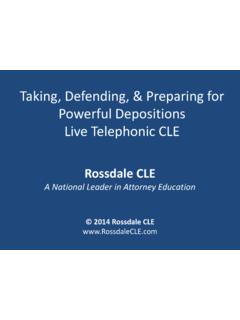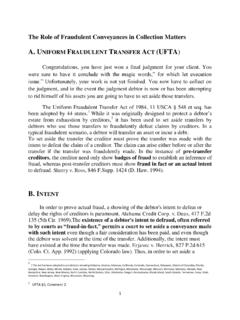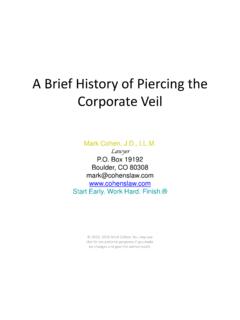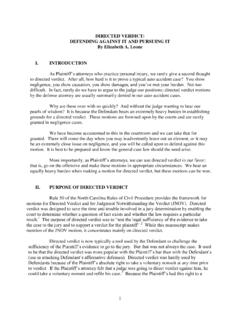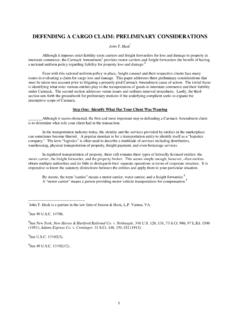Transcription of TIPS FOR SUCCESSFULLY PROSECUTING AND DEFENDING …
1 TIPS FOR SUCCESSFULLY PROSECUTING AND DEFENDING . attorney 'S FEES PETITIONS. CLE PROVIDER: ROSSDALE CLE, Miami, FL. DATE: August 24, 2016. PANEL MEMBER: William M. (Mike) Hensley, AlvaradoSmith, 1 MacArthur Place, Suite 200, Santa Ana, CA 92707;. Phone ; Cell ;. Email: Blog (co-contributor Marc Alexander): I. PROVIDE A ROADMAP FOR THE TRIAL/DISTRICT JUDGE. A. Justice Fybel's key observation at recent Los Angeles County Bar presentation (Cal. Ct. App., 4th Dist., Div. 3). B. attorney credibility is crucial in the presentation and challenge to fee petitions. Examples to avoid: inflated billings (Christian Research Institute v. Alnor, 165 1315, 1320 (2008)); attachment of voluminous billings without an explanation or summary of events;. reconstructed time not necessarily preclusive, but can impact credibility . PLCM Group v. Drexler, 22 1084, 1096 n.
2 4 (2000); Grendel's Den., Inc. v. Larkin, 749 945, 952 (1st Cir. 1984); Cunningham v. County of Los Angeles, 879 481, 484 (9th Cir. 1988); Alvarado v. FedEx Corp., 2009 WL 734683 at *6 ( Cal. Mar. 19, 2009)]; block billing time submissions [in California, trial courts have considerable discretion can deny completely or cut, usually 10-30% based on California State Bar Comm. on Mandatory Fee Arbitration report cited in California state and federal cases, but report not binding on California state court judges Heritage Pacific Financial, LLC v. Monroy, 215. 972 (2013); Jaramillo v. County of Orange, 200 811, 830 (2011); federal courts usually reduce by 10-20%--Welch v. Metropolitan Life Ins. Co., 480 942 (9th Cir. 2007); Ceglia v. Zuckerberg, 2012 WL 503810 at *16-17 ( Feb. 14, 2012)];. examples to embrace: voluntarily reduce fees by certain amounts or by a percentage, to eliminate duplicative, excessive, or novice work; give some thought to apportioning work between successful and unsuccessful claims if work is not inextricably intertwined and may be required in some areas ( , Brandt contexts Susan White, Esq.)
3 To discuss); provide charts and summaries of voluminous billings by significant litigation event or time exercise; if opposing a fee petition, make objections specific in nature. 1. C. Know your jurisdiction/venue and its peculiarities. Examples: competent evidence of attorney work; need for a statement of decision or order showing how lower court did its math ; need for expert testimony;. federal versus state differences ( , multipliers impact of Perdue v. Kenny A., 130 S. Ct. 1662 (2010); in Ninth Circuit, haircut over 10% must be explained Moreno v. City of Sacramento, 534 1106 (9th Cir. 2008).). D. Give the lower court some options. Think like a judge and give a couple of different fee scenarios acceptable to the client. Examples: exclude some time which might be troublesome to judge; exclude truly apportionable time; give credit for minor discounts by other side at earliest stage possible.
4 II. TIPS WHICH WILL LEAD TO A SUCCESSFUL FEE PETITION. A. Make sure you have a fee entitlement basis. Usually, contract or statute . and there are many statutes out there. Focus on whether the fee entitlement is mandatory, discretionary, one-way or bilateral, as well as principles for liberal versus strict construction. B. Look for conflict-of-law issues in fee entitlement. Example: California Civil Code section 1717 versus contracts calling for non-California law to govern. (ABF Capital Corp. v. Grove Properties, 126 204. (2005); ABF Capital Corp. v. Gerglass, 130 825 (2005).). C. Look for instances of judicial or pleading estoppel. D. Think about obtaining discovery or information of the other side's fee work and billings. Federal courts generally friendly in this area; cases listed in June 8, 2008 post. E. Make sure you follow particular time deadlines for filing fee petitions.
5 F. After establishing fee entitlement, utilize lodestar/multiplier enhancement analyses. G. Provide a detailed attorney declaration from lead, supervising, or globally knowledge attorney . Other pointers: summarize the litigation; attach detailed, contemporaneous billing records (or explain why non- contemporaneous billings are reliable and how cross-checked); avoid block billing or explain why reliable; redact only very confidential or privileged entries; apportion out work where appropriate; explain hourly rates and knowledge of rates in the community (usually venue where case is litigated); explain why higher hourly rates allowable for non-venue attorneys litigating case due to lack of availability or that venue rates not 2. that far off; give specific factor-by-factor analysis of lodestar and multiplier requests; indicate what the other side spent as far as rates, hours, and overall expenditures, if information can be obtained; show hourly rates awarded to requesting attorneys in similar cases; obtain declarations from other community attorneys as to rates and reasonableness of fee request; discuss case law which has awarded fees in analogous situations.
6 H. Obtain expert testimony, especially in a complex case or one involving a high fee request. I. Provide appropriate deductions and apportionments. J. Provide the trial/district judge with a statement of decision (unless judge gives a detailed tentative) or proposed order with basic findings and conclusions of law. Confirm a detailed tentative in a proposed final order, so the roadmap is established! K. Submit a detailed opening brief summarizing all of the declarations and fee entitlement bases. L. Do good reply papers confronting the challenges by the opposing side. M. Avoid double dipping on lodestar and multiplier factors (especially in the class action area). N. Avoid misrepresenting the complexity or risks involved in a case. (See, , Frontier Land Cos. v. Jeld-Wen, Inc., Case No. C064351 (Cal. Ct. App. 3d Dist. May 22, 2014) (unpublished) [defense challenged fee award which was 2 of compensatory award as excessive, claiming case was a routine contractual matter; appellate court said no, basing it on defense requests for extension of appeal briefing deadlines where defense claimed matter was complex in nature, done under penalty of perjury].)
7 O. Introduce any pre-motion efforts to settle the fee dispute. P. Introduce evidence as to financial situation of client, where relevant. Q. Summarize retention arrangement with client, subject to confidentiality/privilege concerns. R. Show equitable circumstances (besides enhancement factors) that would support something more than the lodestar request. 3. III. TIPS WHICH WILL LEAD TO A SUCCESSFUL FEE PETITION. OPPOSITION. A. Upfront, confront untimely filing or fee entitlement/lodestar/multiplier issues. Examples: some statutes have specific requirements and the burden of proof is usually on fee claimant (attack elements of fee entitlement statute, attack narrowly worded contractual clauses not giving rise to fee entitlement, and raise attendant BOP issues); Perdue federal court multiplier impact. B. Show why fee claimant did not prevail or only had limited success.
8 May retard any fee recovery or dramatically limit amount of fee recovery. (See, , Chavez v. City of Los Angeles, 47 970 (2010) [FEHA. context].). C. Introduce efforts to compromise the fee dispute. D. Show why pre-trial settlement offers (formal or informal) should result in a reduced award mitigation argument. E. Introduce proof that your hourly rates are way different but commensurate as far as experience for requesting attorneys. F. Provide attorney declarations for venue-based attorneys showing why hourly rates are excessive or should be different. G. Hire a fee expert, if necessary, having practical and expert experience and knowledge of various fee studies available as a basis for expert testimony. H. Show specific objections to work or time entries in order to reduce the amount. Fertile areas for reduction: (1) clerical/secretarial/grunt work.
9 (2) duplicative work, especially more low level work by an experienced attorney ; (3) overstaffing; (4) block billings; (5) lack of contemporaneous time records; (6) overly redacted billings; (7) work on totally unrelated or only marginally related matters; (8) bad billing judgment; (9) vague, non- descriptive time entries; (10) wrong time entries from other cases or matters; (11) excessive inter-conferencing entries; (12) inflated hourly rates look at prior fee awards to attorneys/published and unpublished decisions on hourly rates/and reliable studies which would be used by fee experts; and (13) excessive fees on fees. For a good summary of factors to examine as far detecting potentiai fraudulent/padded billing, see Cal. State Bar Committee on Mandatory Fee Arbitration, Arbitration Advisory 03-10, Detecting attorney Bill Padding (January 29, 2003).
10 4. I. Show your litigation rates, time and total billings in comparison to fee claimants if it shows a disparity. If your work efforts are not comparable, resist producing information or discovery propounded by fee claimant. J. Challenge to non-venue counsel billing significantly higher hourly rates than those customary in the venue-based community. K. Pitch the need for apportionment between compensable and non- compensable claims. L. Consider providing a floor lodestar or other options for the lower court as far as a fee recovery. M. Show why a multiplier is not justified factor-by-factor, especially multiple recovery/double counting arguments in this area. N. Introduce specific evidence as to the financial situation of the client, whether impecunious or stakes in litigation way over individual/group benefit to ever be achieved.
